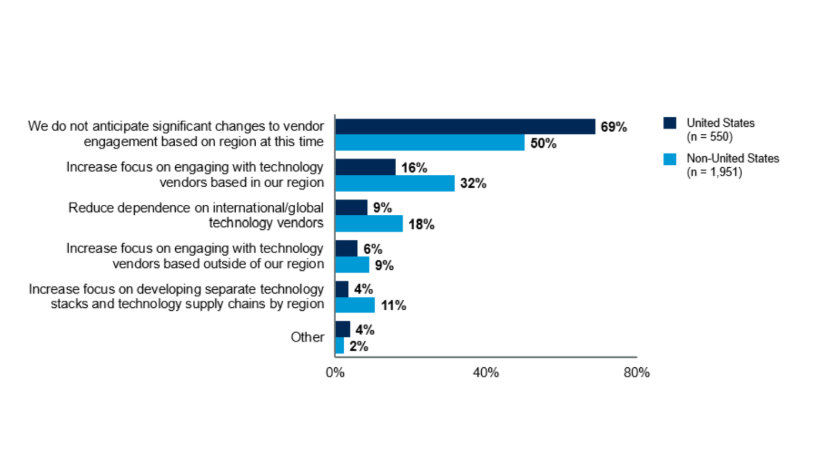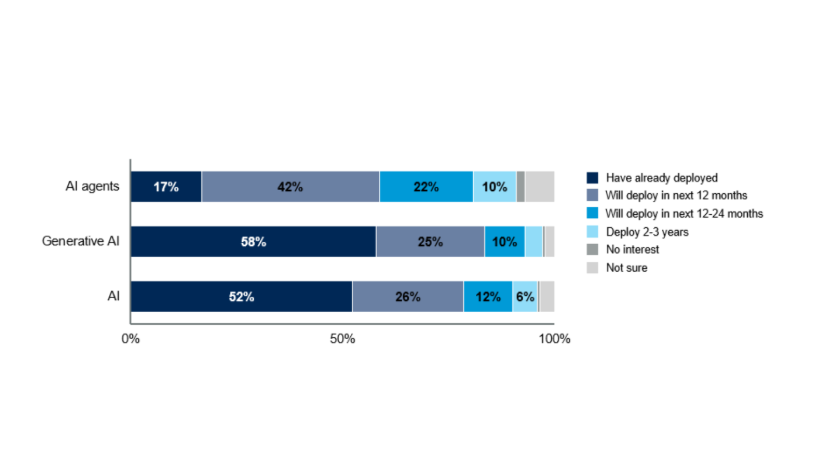Global CIOs are walking a tightrope: balancing innovation with risk, AI ambition with budget pressure, and global reach with regional realities. According to Gartner’s 2026 CIO and Technology Executive Survey, these pressures are shifting how tech leaders think about everything from vendor engagement to AI investment.
Revealed at this year’s Gartner IT Symposium/Xpo, the survey, which includes responses from over 2,500 CIOs and tech execs worldwide, lays out a roadmap for how leaders are adapting.
What worked yesterday won’t cut it tomorrow.
Regional Risk Is Reshaping Vendor Relationships
One of the biggest surprises in this year’s data is a clear divide between U.S. and non-U.S. CIOs when it comes to how geopolitical risk influences vendor strategy.
Half of CIOs outside the U.S. expect to change how they engage with vendors based on regional factors. In contrast, only 31% of U.S.-based CIOs anticipate similar changes.
But, why the gap?
“Driven by the geopolitics of AI, CIOs and technology executives should recognize that vendor geography and data sovereignty risks are now viewed by many of their peers as a critical consideration in developing a global vendor portfolio.”
Chris Howard, Gartner’s Chief of Research.
In other words, where your vendors are based is starting to matter a lot more, especially in regions with stricter regulations or geopolitical friction.
For example, 32% of CIOs outside the U.S. say they’re intentionally shifting focus toward regional vendors. Only 16% of U.S. CIOs say the same.
This could signal the beginning of a bigger change in global tech leadership. As Howard put it: “This may be the beginning of a shift in hegemony that will play out over coming years.”

Source: Gartner (October 2025)
AI Strategy: Moving Beyond Pilots to Agentic AI
While vendor dynamics are evolving, AI continues to dominate the CIO agenda, but now, with a sharper focus on value.
“2025 was about AI pilots, discovery, and experimentation. 2026 will be about delivering agentic AI ROI.”
Kris van Riper, Practice VP at Gartner.
Agentic AI is prepared to be the next major wave. It promises faster time-to-value than earlier GenAI experiments, but success isn’t guaranteed.
To deliver results, Gartner highlights five key areas CIOs must nail:
- A business-aligned AI roadmap
- Clear, measurable value targets
- Workforce upskilling
- Strong data governance
- Resource reprioritization
Without alignment, clarity, and governance, the ROI won’t follow. But many CIOs are ready to make the leap: 64% plan to deploy agentic AI over the next 24 months.

Source: Gartner (October 2025)
AI Spending Grows Even as Budgets Tighten
Despite tight IT budgets, AI spending is going up by more than 35% year-over-year, according to Gartner.
Why? Because AI is not viewed as optional anymore.
It’s becoming foundational, especially in areas like automation, customer experience, and operations.
But with so many possible directions to go, CIOs are now tasked with a more focused challenge: identifying which AI initiatives will actually deliver value. The environment is crowded with pilots and prototypes, and leaders have to now separate novelty from necessity.
One Global Strategy Won’t Cut It Anymore
The survey confirms the growing reality that a unified global IT strategy is hard to pull off.
From data privacy laws to trade tensions, local and regional factors are forcing CIOs to build more nuanced, geography-specific strategies.
The divergence between U.S. and non-U.S. CIOs on vendor engagement is just one example.
And as digital sovereignty becomes a board-level concern in more countries, expect even more fragmentation in how global IT ecosystems operate.
At the same time, the expectations for CIOs are only growing.
Trusted insights for technology leaders
Our readers are CIOs, CTOs, and senior IT executives who rely on The National CIO Review for smart, curated takes on the trends shaping the enterprise, from GenAI to cybersecurity and beyond.
Subscribe to our 4x a week newsletter to keep up with the insights that matter.
The Wrap
Gartner’s latest findings paint a picture of a CIO space in transition. The pressures are real, but so is the opportunity.
Whether it’s adapting vendor strategies to a changing world or moving from AI pilots to AI performance, it is clear that CIOs have their hands full.
2026 is a turning point.
The organizations that come out ahead will be led by CIOs who can translate complexity into strategy, risk into resilience, and emerging tech into real business value.







